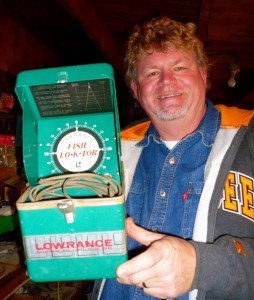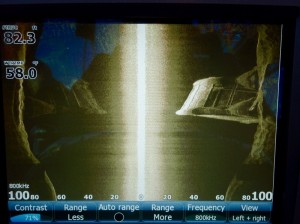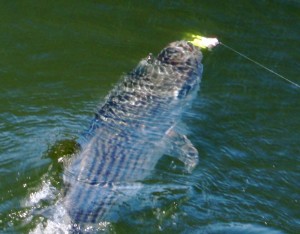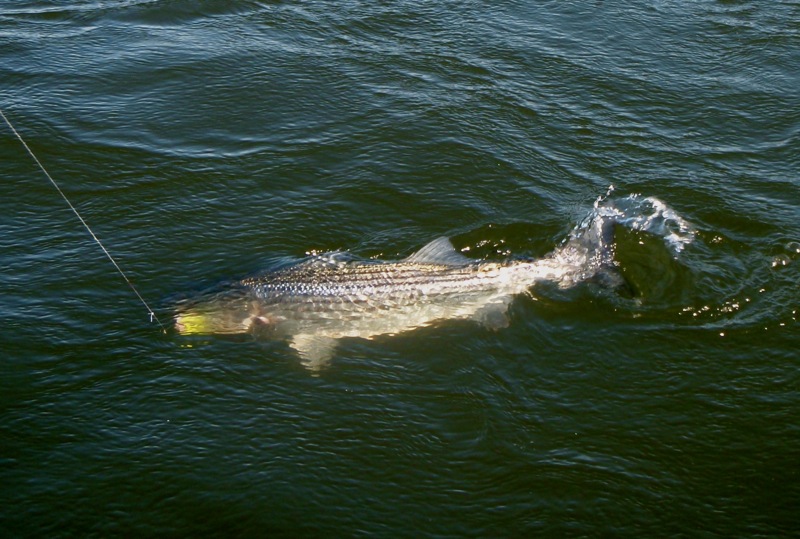 I’ll never forget the first sonar unit I ever saw. I was only five or six years old when my dad installed a Lowrance Fish Lo-K-Tor. I was fascinated by the technology. It took two big six volt batteries with springs on top. There was one knob on the front to adjust the gain and a diagram behind the dial to show the cone angle. The transducer attached with two suction cups and could be taken on or off anytime. Not only could we read the bottom depth, but with a little practice we could interpret the red flashes around the dial to find fish. There was nothing more exciting than seeing that dial light up. Quick sparks meant bait, solid lines meant fish, wider solid lines meant big fish. The “Little Green Box” revolutionized fishing. My dad was always ahead of the game when it came to technology, but I admit I haven’t always kept up with the latest and greatest in gadgetry. In fact, I was still using a Lowrance flasher on my small boat when I first started fishing the Chesapeake four years ago. When color graphic screens came out I thought they were nice, but I didn’t see them as a giant leap forward. Even though I bought one for my big boat, I still trusted the flasher to put me on fish. Things changed when side-scan sonar became affordable for amateur fishermen. Just like those Fish Lo-K-Tors in the early 1960s, side-scan has opened a new chapter in 21st century fishing technology.
I’ll never forget the first sonar unit I ever saw. I was only five or six years old when my dad installed a Lowrance Fish Lo-K-Tor. I was fascinated by the technology. It took two big six volt batteries with springs on top. There was one knob on the front to adjust the gain and a diagram behind the dial to show the cone angle. The transducer attached with two suction cups and could be taken on or off anytime. Not only could we read the bottom depth, but with a little practice we could interpret the red flashes around the dial to find fish. There was nothing more exciting than seeing that dial light up. Quick sparks meant bait, solid lines meant fish, wider solid lines meant big fish. The “Little Green Box” revolutionized fishing. My dad was always ahead of the game when it came to technology, but I admit I haven’t always kept up with the latest and greatest in gadgetry. In fact, I was still using a Lowrance flasher on my small boat when I first started fishing the Chesapeake four years ago. When color graphic screens came out I thought they were nice, but I didn’t see them as a giant leap forward. Even though I bought one for my big boat, I still trusted the flasher to put me on fish. Things changed when side-scan sonar became affordable for amateur fishermen. Just like those Fish Lo-K-Tors in the early 1960s, side-scan has opened a new chapter in 21st century fishing technology.
 When I was outfitting my boat Thunder Road for Chesapeake fishing, I knew I had to add side-scan sonar. Both Lowrance and Huminbird make good units but I’ve always used Lowrance so I went with their “StructureScan” version. Just like the early flashers, there is a learning curve involved. Since fishing has been tough this April, I’ve had some time to familiarize myself with my unit. I still have a lot to learn, but I feel like I’m getting close to having it “dialed-in.” The picture to the left is a StructureScan image of a deep piling on the Bay Bridge. Since I have my unit set to “left and right” side scan with a view of 100 feet on each side, the piling looks sideways and somewhat small on the screen. Click the photo to enlarge and see the incredible detail, or click this link for even more detail. Yes, that’s a cable running down the front, and yes, those dots are probably jigs on the cable! I’ve been jigging this piling for years, but I never knew how it widened out near the bottom. On the other hand, I did know about that cable, I’d bet a lot of those jigs are mine! There’s also some debris around the base of the piling that I didn’t know about. It looks like big timber which will surely hold fish when there is enough oxygen that deep.
When I was outfitting my boat Thunder Road for Chesapeake fishing, I knew I had to add side-scan sonar. Both Lowrance and Huminbird make good units but I’ve always used Lowrance so I went with their “StructureScan” version. Just like the early flashers, there is a learning curve involved. Since fishing has been tough this April, I’ve had some time to familiarize myself with my unit. I still have a lot to learn, but I feel like I’m getting close to having it “dialed-in.” The picture to the left is a StructureScan image of a deep piling on the Bay Bridge. Since I have my unit set to “left and right” side scan with a view of 100 feet on each side, the piling looks sideways and somewhat small on the screen. Click the photo to enlarge and see the incredible detail, or click this link for even more detail. Yes, that’s a cable running down the front, and yes, those dots are probably jigs on the cable! I’ve been jigging this piling for years, but I never knew how it widened out near the bottom. On the other hand, I did know about that cable, I’d bet a lot of those jigs are mine! There’s also some debris around the base of the piling that I didn’t know about. It looks like big timber which will surely hold fish when there is enough oxygen that deep.
Another advantage of StructureScan is the detail it provides in identifying bait. The Lowrance unit has a “Downscan” feature that provides a view that is oriented just like the sonar image on a traditional fish finder. On regular sonar, schools of bait fish show up as indistinct blobs, but on Downscan I can easily identify the size and orientation of each individual fish.
Identifying the size of the bait is important because big fish prefer bigger bunker. When I can find the big bait pods, I know trophy stripers may be lurking nearby. In fact, I’ve put that theory to the test this week. The fish have been hard to catch, but there are a few around. It’s still catch and release season, so I don’t have many pictures. Almost all my fish were released boat-side and never taken out of the water. With water temps in the mid-fifties, rockfish are now spawning in the rivers.
bigger bunker. When I can find the big bait pods, I know trophy stripers may be lurking nearby. In fact, I’ve put that theory to the test this week. The fish have been hard to catch, but there are a few around. It’s still catch and release season, so I don’t have many pictures. Almost all my fish were released boat-side and never taken out of the water. With water temps in the mid-fifties, rockfish are now spawning in the rivers.
Despite my nostalgia for the old stuff, we’ve come a long way from those red flashes on the Lo-K-Tor dial. Stay tuned to ChesapeakeLightTackle.com since I’ll surely post more StructureScan pics as I encounter interesting situations. Post-spawn striper patterns should begin in the next couple of weeks and I’ll be fishing close to home. I hope to get even more detailed shots of familiar underwater structure like the Bay Bridge. Thanks to this exciting technology it’s just a matter of time before we find even more of what we’ve been missing down there.





That piling scan is unbelievable. It’s almost like cheating at this point. For us bay bridge fisherman, it’s almost worth the price of the upgrade just to be able to scan those pilings like that.
Technology is pretty amazing.
Mike, this is the south side of one of the 4-banger columns. This view doesn’t show the top 20 feet, so you don’t see the ledge under the cross-bar where the fish usually hang out. But the visible rectangle toward the top is also a “window” that goes all the way through. I didn’t know about that either and always just fished the top one.
Shawn,
Incredible images for sure. I’ll have to get a side scan when the time comes to replace my existing humminbird chartplotter. yes, the new technology is almost cheating, and I’ve told Pop so, but you still have to be good to catch fish. Thanks for writing.
Don
Shawn,
I’m fishing mid-bay, and looking for variety in that experience. I grew up perch fishing upper bay, then became obsessed with fresh water large mouth for years. Now I’m lucky to live in this area. This was the stuff of legends when I was a kid. I love trying the different locations and techniques, and have perfected nothing so far.
I’m getting ready to purchase a new CP/FF combo, and decided to go with the Lowrance HDS.
But due to budget, last thing holding me up is decision between HDS-7 with Structure Scan, or HDS-8 w/o SS.
Push come to shove – what would you recommend?
Thanks – enjoy your writing and perspective.
Gary, if I were making that decision I would go with the 8 now, then wait and maybe add the SS option later on. There’s a big difference in the screen size on those two. I don’t use the SS very much in the open bay. It’s a lot more useful for identifying stuff like underwater cover, wrecks, bridge pilings, etc. so I put it in the nice option to have but not really necessary category. Good luck!
-Shawn